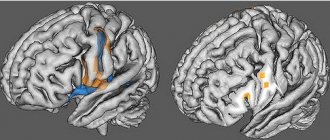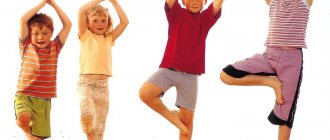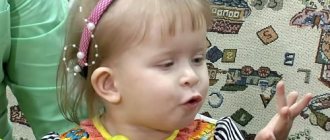Dysarthria is a speech pathology in which incorrect (distorted or difficult) pronunciation of sounds, words, phrases, and syllables is observed. This speech disorder is caused by brain damage or various disorders of the articulatory apparatus (which is why you can often find the expression “articulatory dysarthria”).
This disorder can be observed with normal intelligence, against the background of mental retardation and with mental retardation - oligophrenia, then it has specific features. For dysarthria, specialists often use speech therapy massage.
The following symptoms of dysarthria can be distinguished:
- disorders associated with speech motor skills;
- violation of sound pronunciation;
- improper speech breathing;
- voice disorders;
- violations of the prosodic side of speech.
Organic damage to the central nervous system in this case occurs in the prenatal, birth or early stages of a child’s development (usually up to 2 years). That is why, as a rule, experts talk about the development of dysarthria in preschool children.
In addition, in early childhood, damage to the central nervous system and speech dysarthria in a child can develop as a result of the following diseases:
- neuroinfections (miningitis, encephalitis);
- purulent otitis media;
- hydrocephalus;
- traumatic brain injuries;
- severe intoxication.
Forms of dysarthria are classified based on the identification of different locations of brain damage. When correcting dysarthria, the First Children's Medical Center uses various methods of speech therapy.
The degree of impairment of speech or articulatory motor skills may vary. Conventionally, there are three degrees of dysarthria: mild, moderate, severe.
1. A mild degree of dysarthria (erased dysarthria) is characterized by defects in sound pronunciation, as well as the absence of gross violations of the motor skills of the articulatory apparatus.
2. Children with moderate speech dysarthria make up the largest group. They are characterized by amicity: lack of movement of the facial muscles.
3. Severe degree of dysarthria (anarthria) - deep muscle damage and complete inactivity of the speech apparatus.
Diagnosis of dysarthria should include a thorough examination of speech motor skills, sound pronunciation and general speech development.
Symptoms of the disease
The symptoms of pseudobulbar dysarthria depend on the severity, of which there are only four:
- 1st degree – there are no pronounced speech defects, which can be identified by a speech therapist.
- 2nd degree – the child’s speech is understandable, but some speech disorders are noticeable.
- 3rd degree – speech is incomprehensible to people around, including loved ones.
- 4th degree – the patient’s speech is not completely understandable.
The general symptoms of this form of dysarthria have some components:
- distorted syllables, sounds;
- hypertonicity of the facial muscles;
- limited mobility of the tongue and lips;
- increased salivation;
- weak quiet voice;
- arrhythmia of breathing.
A diagnosis of “pseudobulbar dysarthria” can only be made by a speech therapist or neurologist based on certain research results.
Dysarthria in adults: causes
Adults can also develop dysarthria, the causes of which are different:
- Brain injury.
- Hemorrhagic or ischemic stroke
- Neuroinfections.
- Brain tumors.
- Demyelinating diseases.
- Vascular insufficiency.
Unlike children, adults do not lose the ability to understand other people's speech. As a result of the development of various diseases or injuries, the patient’s coordinated and simultaneous work of neuromuscular systems is disrupted. Dysarthria develops. As a result of disruption of the respiratory system, the voice fades, impaired articulation leads to unintelligibility of speech, damage to the central nervous system disrupts the motor activity of various muscle groups, including the articulatory apparatus. At the Yusupov Hospital, patients with speech disorders are treated with medication therapy, exercise therapy, classes with a speech therapist, and various physiotherapeutic procedures. You can make an appointment with a doctor by phone.
Causes of speech impairment
Speech disorders occur when the pathways between the bulbar nerves and the cerebral cortex are damaged. This can occur for a number of reasons:
- Cerebrovascular disorders. These are strokes, cerebral ischemia, cerebral atherosclerosis. These diseases often lead to the development of pseudobulbar disorders, leading to disorders of the speech apparatus.
- Head injury. This reason is most common for children over one year of age.
- Perinatal pathology. This group includes fetal hypoxia, intrauterine infections, and birth trauma. As a result of these processes, functional corticobulbar disorders occur.
- Neuroinfections.
For all these reasons, with pseudobulbar dysarthria, the structure of the speech defect suffers and is disrupted.
Causes and symptoms
The disease is provoked by a number of harmful factors:
- viral diseases of the expectant mother;
- pathologies of the placenta at the stage of intrauterine development;
- Rhesus conflict;
- fetal hypoxia;
- very rapid or slow labor with cerebral hemorrhage in the child;
- some birth injuries;
- prematurity;
- infections of the brain and its membranes, such as meningitis;
- Cerebral palsy (up to 85% of cases of dysarthria);
- TBI;
- hydrocephalus;
- severe intoxication;
- encephalitis. Source: L.I. Belyakova, Yu.O. Filatova Diagnosis of speech disorders // Defectology, 2007
Forms of pseudobulbar dysarthria
There are three forms of this type of dysarthria:
- spastic (spasmodic);
- paretic;
- mixed (that is, spastic-paratic).
Each of these forms has its own symptoms and treatment features.
Spastic form of pseudobulbar dysarthria
This form of pseudobulbar dysarthria is characterized by tension of the respiratory muscles or hyperkinesia of the larynx, spastic paresis of the lingual muscle, tension of the labial muscles and impaired tone of the palate.
Such manifestations make speech more monotonous, with a nasal tone. It is difficult for a child to maintain articulatory postures, there are difficulties in switching them, and the breathing process may take a long time, which leads to problems in voice formation (articulation). With pseudobulbar dysarthria, the following characteristic phenomena are observed:
- silent articulation;
- there is no prolonged rest of the speech muscles;
- spasms of the labial muscles;
- tension when smiling;
- limited tongue movements;
- disturbances in sucking and swallowing movements are observed;
Often in children with this disorder, the first cry is absent, and breathing is pronouncedly weak and arrhythmic, there is a weak short exhalation, and speech occurs while inhaling. This species is also characterized by the presence of speech phonations, a weak, quiet voice, the rate of speech is fast, but its rhythm is not maintained. In other words, someone who has a spastic form of pseudobulbar dysarthria speaks from spasm to spasm, which leads to the use of short phrases with poor intelligibility, depending on the strength of the voice. At the same time, the meaning of what was said does not suffer.
Paretic form of pseudobulbar dysarthria
This form is observed with hypotonia of the speech and skeletal muscles. The child has pareticity of the tongue, lips, and palate. There is difficulty in switching articulatory postures, asynchrony in breathing and articulatory movements. Often such a child may have increased salivation (salivation).
The inhalation during conversation is short and inadequate, and the exhalation is also weak. The voice itself is loud, ringing, but quickly fading. Speech in this case has a nasal pronunciation, weak and quiet. Some isolated sounds are completely preserved, but in the speech stream they are blurred. Eating is at a disturbed pace and there are difficulties in coordinating chewing movements.
Mixed form
This form is the most common. In the scientific literature it is called spastic-paretic syndrome. With it, there is hypertonicity of one muscle group, for example, the muscles of the lips and cheeks, while the tongue has reduced tone.
Dysarthria - symptoms and treatment
The following forms of dysarthria are distinguished depending on the damage to brain structures [9].
Bulbar dysarthria is a consequence of damage to the bulbar group of cranial nerves: glossopharyngeal, vagus and hypoglossal. Characterized by weakness of articulation muscles, decreased muscle tone. As a result, speech is slurred, extremely slow, and the face is depleted of facial expressions.
Subcortical dysarthria occurs with lesions of the subcortical nodes of the brain. It is distinguished by the presence of hyperkinesis - violent facial movements uncontrollable by the child. Muscle tone changes from normal to increased. The tempo-rhythmic organization of speech suffers.
Cerebellar dysarthria is observed when the cerebellum or its connections with other structures of the nervous system are damaged. It is distinguished by scanned, “chopped” speech. There is no smooth transition from one word to another.
Cortical dysarthria , as the name suggests, is associated with damage to the cerebral cortex, namely, the lower part of the anterior central gyrus of one or both hemispheres. Also, cortical dysarthria is diagnosed when the dominant hemisphere is damaged (for right-handers - left, for left-handers - right) in the lower postcentral parts of the cortex. Children with this form are good at mastering isolated pronunciation of sounds, but have great difficulty using them in the flow of speech, and sometimes skip them altogether.
Pseudobulbar dysarthria is noted with bilateral damage to the motor corticonuclear tracts connecting the nuclei of the cranial nerves of the brain stem with the cortex. Characterized by the inability to organize clear rhythmic movements. In early childhood, such a child often chokes and has difficulty chewing; at an older age, a number of speech problems are discovered due to poor mobility of the articulatory muscles; speech is extremely slurred.
There are several degrees of dysarthria [6]:
First degree. Most often they talk about erased dysarthria; in this case, defects in sound pronunciation may be barely noticeable to others. They are identified by a speech therapist and, when corrected, are particularly resistant, which means that a lot of time and effort will have to be spent. As a rule, such children are seen by a neurologist at 1-2 years of age, but thanks to the plasticity of the child’s nervous system, many symptoms are compensated for by 4-5 years, and the child “outgrows” them. An unpleasant surprise is persistent problems with sound pronunciation in preschool age.
Second degree. Defects in sound pronunciation are very noticeable to others, but overall speech remains understandable. Along with speech symptoms, psychological symptoms are also observed. Often there is a deficiency of fine and gross motor skills, some clumsiness, behavioral disorder, emotional-volitional disorder, attention deficit disorder, hyperactivity, etc.
Children with the first and second degrees of dysarthria, as a rule, have fairly intact thinking.
Third degree. Understanding the speech of a dysarthric child is difficult for others. It is often not clear what the child is saying. Non-speech symptoms are extremely pronounced. A critical level of speech underdevelopment has the most negative impact on the behavior and thought processes of the child. We can talk about disruption of almost all mental functions: memory, attention, thinking, emotional-volitional sphere, etc.
The fourth is the most severe degree. Speech is almost always incomprehensible even to the closest people or is absent altogether.
You can count on complete correction of sounds in speech with the first and second degrees. The third and fourth degrees are diagnosed for severe lesions, for example, in children with cerebral palsy (CP), the prognosis for correction here is less optimistic.
Diagnosis of pseudobulbar dysarthria
The patient should be managed by a speech therapist, neurologist and other specialized medical specialists. For accurate diagnosis, the following research methods are used:
- speech therapy speech study;
- electroencephalography;
- electromyography;
- MRI of the head.
In some cases, a study of cerebrospinal fluid by lumbar puncture may be prescribed. This analysis identifies neuroinfectious causes. A neurologist should participate in the diagnosis. They must undergo an examination, special tests, and a study of the child’s motor skills and facial expressions. These methods make it possible to assess the degree, type, and causes of the disorder, and also, based on the data obtained, formulate an effective treatment program.
Treatment of pseudobulbar dysarthria
Corrective work is based on speech therapy sessions and exercises. They are carried out under the supervision of a specialist and are aimed at developing fine and speech motor skills. In some cases, drug treatment may be used. General correction of this form of dysarthria consists of:
- physiotherapy;
- therapeutic physical culture;
- taking baths;
- reflexology and others.
Nootropics are used for drug treatment. It is important to understand that early diagnosis is extremely important in this matter. All therapeutic measures of the correction program should be prescribed exclusively by a specialist; self-medication can be dangerous.
For correction, etiopathogenetic treatment is used. It eliminates the etiological factors of speech development. If dysarthria is caused by neuroinfections, it is necessary to prescribe antiviral and antibacterial therapy. Treatment methods depend on the causes of this speech disorder.
An important part is special speech therapy classes. For hypertonicity, speech therapy massage, breathing exercises and other exercises can be used. This part of the correction is aimed at obtaining fluency of speech, its emotionality and expressiveness.
Erased dysarthria in children
Erased dysarthria, as mentioned earlier, is the first degree of severity of dysarthria. With this disorder, mild disorders of the phonetic and prosodic (voice strength, tempo, rhythm, intonation) components of speech are observed. These disorders are caused by insufficient supply (innervation) of the articulatory organs with nerve cells.
The following characteristics of this speech defect are noted:
- unclear articulation;
- distortion of sounds of several phonetic groups;
- complexity of automation;
- unimpressive speech.
Correction of erased speech dysarthria involves the use of articulation, breathing and finger exercises, as well as speech therapy massage. Particular emphasis is placed on automating evoked sounds and normalizing prosody. Classes with a speech therapist are carried out in parallel with treatment by a neurologist. When treating, it is necessary to take into account the characteristics of dysarthria - the severity of the pathology, its type, as well as the level of speech development of the child.
Difference between bulbar dysarthria and pseudobulbar dysarthria table
The main differences between bulbar dysarthria and pseudobulbar dysarthria are as follows:
- They differ in the characteristics of paralysis of the speech muscles. With the bulbar type, peripheral paresis is observed, and with pseudobulbar paresis it is central.
- With bulbar, voluntary and involuntary movements of speech motor skills are disrupted. With pseudobulbar, only voluntary sounds are affected.
- With bulbar dysarthria, diffuse articulatory motor skills are affected, and in the second type, a selective nature of the violation of articulatory movements is observed.
There are also differences in sound pronunciation. The bulbar type makes the pronunciation of vowels neutral.
Possible complications
Speech impairments make it difficult, and in some cases completely eliminate, communication with other people. Understanding the presence of a problem with articulation, the inability to convey information to others negatively affects overall mental health, and can also lead to neurotic disorders such as neurasthenia, depression and others. With dysarthria, difficulty eating is often observed. A person often chokes on food and water, which can lead to asphyxia or aspiration pneumonia.
Children suffering from pseudobulbar dysarthria often experience general speech underdevelopment (GSD), which in turn is dangerous due to dyslexia and dysgraphia. Children with a mild form may encounter problems at school (communicating with teachers and classmates). Children with moderate and severe forms are trained in specialized schools. If correctional work is not carried out with the child on time, there is a likely risk of developing intellectual disability and general mental retardation.
What to do? Treatment methods for the disorder
The child must undergo additional classes with a speech therapist (at home or in a special institution) on:
- development of motor skills;
- forming a conversation;
- honing diction;
- correcting the pronunciation of distorted sounds;
- expanding vocabulary;
- development of phonetic hearing;
- memorizing grammatical structure.
Against this background, drug therapy is carried out using nootropics. Medicines in this group specifically affect brain functions: stimulate mental activity, cognitive functions, increase learning abilities, and improve memory.
The package of measures also includes exercise therapy - articulation gymnastics to strengthen the facial muscles, massage, exercises with the hands and fingers.
Sources:
- E.F. Arkhipova. Erased dysarthria in children: a textbook for university students // M.: AST: Astrel: KHRANITEL, 2006, p. 319.
- L.I. Belyakova, Yu.O. Filatova. Diagnosis of speech disorders // Defectology, 2007.
- 3. O.Yu. Fedosova. Features of sound pronunciation of children with mild dysarthria // Speech therapist in kindergarten, 2005, No. 2, pp. 36-41.
The information in this article is provided for reference purposes and does not replace advice from a qualified professional. Don't self-medicate! At the first signs of illness, you should consult a doctor.









